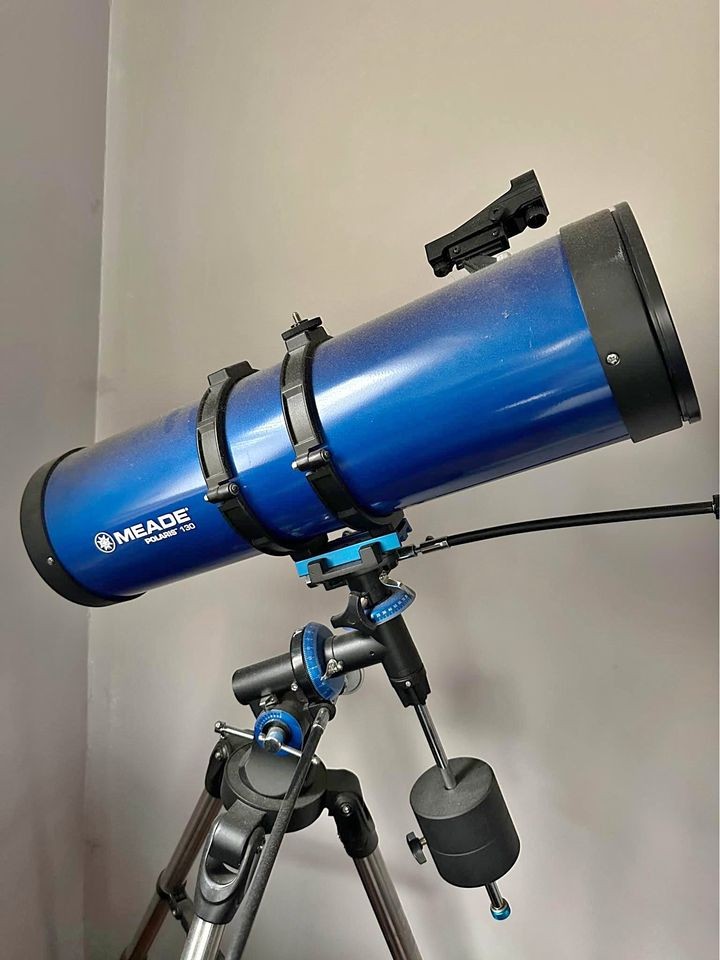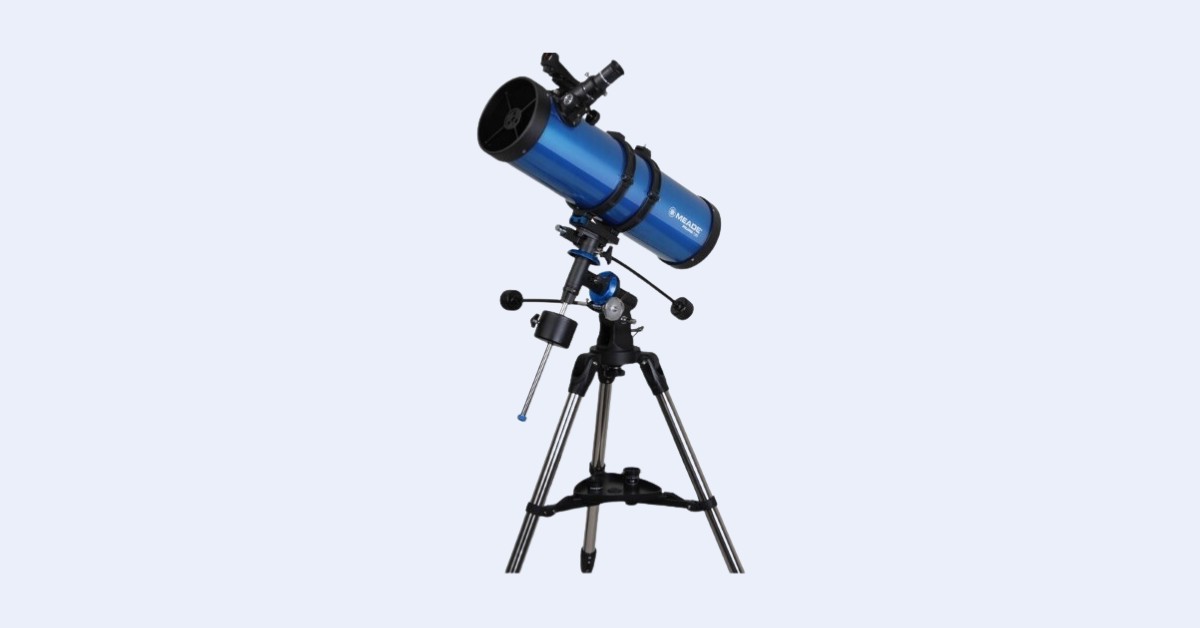Meade’s Polaris line promises decent aperture scopes with good equatorial mounts and decent accessories bundled together – something that a lot of manufacturers promise and fail to deliver.
Even in the Polaris line, I’ve come across a dud, the Polaris 127EQ, as it offers identical optics to the much-derided Celestron Powerseeker 127EQ. From my experience, one must always be cautious when shopping for scopes such as these.
The Polaris 130 is overall a good scope, but I find its construction quality and the accessories a bit iffy, leading me to recommend something else.
The Polaris 130MM Optical Tube

The Polaris 130 is a standard 130 mm f/5 (focal ratio) Newtonian with a parabolic primary mirror. This is key as there is at least one 130 mm f/5 Newtonian on the market from a reputable manufacturer that ships a useless spherical primary.
At f/5 you may begin to notice some coma creeping in at the edges of the field of view with a low power eyepiece. However it’s not really enough to significantly distort your view, and there aren’t any 1.25 inch coma correctors in the market anyway.
Both the primary and secondary mirrors in the Polaris 130EQ can be collimated, which is to be expected with any decent reflecting telescope.
The scope’s 1.25 inch rack and pinion focuser is mostly plastic, but the eyepiece holder is metal and as a whole the unit works fine. The eyepiece holder actually has T-threads on it so you can use a T-ring to screw on your DSLR camera with no additional adapter … though this has limitations which we will examine later.
The scope comes with tube rings and a Vixen dovetail which allows it to be put on another mount if you wish, and of course for the optical tube to be rotated and balanced.
One of the tube rings has a captive ¼ 20 screw, so you can piggyback your DSLR camera and lens on top of the scope, but this again has limitations.
Polaris 130 Accessories
The Polaris 130EQ comes with an astounding three eyepieces and a 2x Barlow – quite a large bundle for a beginner scope, especially at its price.
The eyepieces supplied with the Polaris telescopes are all plastic 1.25” Kellners. These are a 26 mm (25x), a 9 mm (72x), and a 6.3 mm (103x), which can all be used with the 2x Barlow to double their respective magnifications to 50x, 144x, and 206x.
None of these eyepieces are of particularly high quality and all perform adequately at best with an f/5 telescope, which has a rather demanding and strict tolerance for eyepieces. However, having a variety of magnification options with the stock eyepieces does give you the ability to get decent high power views of the Moon and planets without purchasing anything extra and you can always upgrade to higher quality eyepieces later.
The 2x Barlow lens supplied with the Polaris is almost entirely plastic. I think even the lens might be plastic. It works surprisingly well though, but I would still swap it out for a better unit, or simply forego its use entirely if you can.
The Polaris 130 also comes with a cheap, all plastic red-dot finder. It works fine, and is certainly better than a cheap 5×24 or 6×30. But the plastic window that you look through and which the red dot is projected on is slightly tinted, which dims your view of the sky. It will work, and replacing it isn’t economical, but it’s certainly not an ideal finder.
Mount
The Polaris telescopes all come on the same mount, an EQ-2 with 1.25” steel legs, a single counterweight, and flexible slow-motion controls.
The 130 mm f/5 optical tube is at about the maximum weight capacity that the EQ-2 can sustain. Were it any longer it would probably be unusable on the mount. The 114 mm Polaris with its three-foot-long tube is incredibly shaky on the EQ-2 mount, despite being lighter than the 130 mm f/5 optical tube.
Because of this, you will be straining the mount’s capability if you attach or piggyback a DSLR camera on it, and I don’t recommend doing that. You will grow frustrated trying even a piggybacked shot, and forget long exposure astrophotography.
For planetary and lunar photography, where one records video and stacks it with a program like Registax or AutoStakkert, your biggest problem will be the scope bouncing and wobbling as you turn the right ascension knob to track the sky.
Meade sells an RA motor drive that will somewhat alleviate the problem, but all in all you simply cannot attach a DSLR to the Polaris 130 on its lightweight mount.
For visual use, the EQ-2 is adequate, but not the steadiest. And as with any equatorial mount, there’s a steep learning curve to getting it to work well.
Alternative Recommendations
For similar prices to the Meade Polaris 130, there are a number of other scopes you might want to consider:
- The Zhumell Z114 doesn’t have as much aperture, but it’s on a more stable mount and is a lot easier to use.
- The Zhumell Z130 has a similar optical tube to the Polaris 130, but it’s on a simpler tabletop Dobsonian mount.
- The Sky-Watcher Heritage 130P has the same optics as the Polaris and Zhumell 130, but in a collapsible tube making it easy to transport – even in a backpack.
- The Orion StarBlast II 4.5EQ has a bit less aperture than the Polaris 130, but is more stable and comes with superior accessories.
Aftermarket Accessory Recommendations
The Polaris 130 already comes with a set of eyepieces that are acceptable quality, so to upgrade from them requires spending a fair amount of money. A 6mm “gold-line” (108x) doesn’t deliver much sharper views than the included 6.3mm Kellner, but has a wider field of view and is easier to look through. An Astromania 4mm planetary eyepiece will provide 162x and allow you to ditch the low-quality included Barlow.
If you want hands-free tracking (which helps with keeping the scope stable, a Celestron Logic Drive fits on the Polaris mount with a couple minutes of installation work and runs off a 9-volt battery, allowing you to linger at the eyepiece for minutes at a time without having to adjust the scope, even at high magnification.
What can you see?
Visually, the Polaris 130EQ is great for deep sky viewing with its 130 mm aperture and wide field of view. You can complete the entire Messier catalog from the suburbs, and of course, see many other deep sky objects. There are some who have completed the far more challenging Herschel 400 and even 800 catalogs with a five inch telescope like the Polaris 130EQ given practice and dark skies.
However, while you may be able to see a lot of deep-sky objects under dark skies, don’t expect too much in the way of detail with any 5” telescope. At best, you can begin to resolve some of the brighter globular clusters and see hints of the spiral arms in galaxies like M51, M33, and M101. Other galaxies like M31 and M82 will show their dust lanes easily. Planetary nebulae are small colored dots, with the larger ones like M57 and M27 showing details. Emission nebulae like Orion and the Swan, along with open star clusters, are by far the most visually interesting targets with the Polaris 130EQ,
Concerning the moon, planets, and double stars, the Polaris 130EQ does quite well, though you’ll need some decent, quality planetary eyepieces to get all the scope can offer. Good collimation is also critical given that the Polaris 130EQ is an f/5 Newtonian. But you’ll have no trouble spotting the phases of Mercury and Venus, dark spots and the ice caps on Mars, Jupiter’s cloud belts and Great Red Spot, Saturn’s rings and cloud belts, and the moons of both of the gas giants. Uranus and Neptune are little more than green-blue colored dots; their moons are too dim to spot with this size telescope.




question:
You said “There are only a handful of telescopes at the same or lower price that I could truly, objectively deem better than the Polaris 130”
*can you tell me what a few of these are ?
I am in the process of buying my first scope, would like a 130 mm. I have really been wanting to see Saturn’s rings, Jupiter, details of moon craters, etc.
thanks
https://telescopicwatch.com/best-telescope-reviews/
How does this compare to the Polaris 127 EQ?
Thank you!
Superior optically. The 127EQ is a rebranded PowerSeeker 127EQ tube which is a godawful Bird-Jones.
What would you replace the red-dot finder with for this scope? (mine stopped working)
Probably this: https://www.amazon.com/Astromania-Finder-Deluxe-Telescope-Reflex/dp/B0140UA2OY/
Or a Rigel Quikfinder.
This versus the Orion StarBlast II 4.5? I am a pure beginner looking to have a fun time with my 6 and 12 year olds. Of course you rate the Orion higher but it seems to be out of stock everywhere. I am wondering whether it’s worth waiting for it to be back in stock or just get the Meade? The extra eyepieces are certainly compelling.
Get the StarBlast or a tabletop Dob such as the Zhumell Z130/114/100, or the Orion XT4.5, or an AWB OneSky, or a full-sized 6″ Dob
I’ve been told personally by a Meade customer service representative that the primary is actually spherical not parabolic. I just wanted to let you know
What do you think of the Meade Polaris 114? It’s a bit cheaper and has a much longer focal ratio so I figure that it would be easier for a 10 year-old that won’t have the patience to learn to collimate a telescope.
The $100-$200 price range seems to be dominated by either fast F/4 – F/5 Newts that may be hard to collimate, or refractors with smaller apertures cannot magnify as much as I’d hope. The Meade Polaris 114 and the Orion SkyQuest XT 4.5 are the only reflectors with longer focal ratios that I’ve found, and between them, the Polaris 114 is $100 cheaper.
Mount is too small for the scope.
f/4 and f/5 Newtonians are not nearly as hard to collimate as you probably think.
Thanks! That’s very helpful.
Alright, do you think that a telescope like the Polaris 130mm reviewed here, or the Orion StarBlast II 4.5 or StarBlast 4.5 would be a good choice for a 10 year-old? They’re all F/4 or F/5 Newtonians, same aperture, and they all get high marks on this website.
I’d get the StarBlast 4.5 or a Zhumell Z130
Hi,
I am debating between this one, Explore Firstlight 130mm EQ3 and a Celestron Astromaster 130EQ with Motor Drive. Mainly trying to view and capture DSOs, so something which can hold a DSLR as well.
Which of these would you think is a better option?
Thanks!
Don’t get any of them and forget about astrophotography at your budget. A Dobsonian is the only good option below $300-$400 USD
Can you use the Celestron Astro clock drive on the Meade 130mm mount?
Yep! You can
I wanted to know if I should buy the Orion xt6 and if I can see more celestial objects with it, I am kind of a beginner and also don’t want a Dobsonian because I don’t anything to place one on so I would like to know which telescope I should buy.
You don’t need to set the XT6 on anything to use it – it’s plenty tall to just place on the ground.
Hi. I have Canon EOS 1100D DSLR. İ want attach to a telescope. And you tell me i cant do that with meade Polaris 130eq. What should i do? Do you recommend astromaster 130eq?
The AstroMaster is worse in quality and neither is any good for astrophotography
Hi Zane
Which one is better astromaster 130 eq or meade 130 eq?
The Meade is much better.